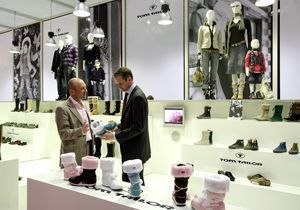
Big problems of a small team

On the eve of the spring exhibition season, we decided to investigate one of the key parameters of work efficiency at the stand - team coherence, which becomes the face of the company during the exhibition. Svyatoslav Kurzner, General Director of CJSC Mobile Exhibition Technologies, Head of the Exhibition Business Department at MBI, talks about the mistakes made by the stand attendants' team and the possibilities for their elimination. It revises traditional approaches and provides practical recommendations for improving efficiency.
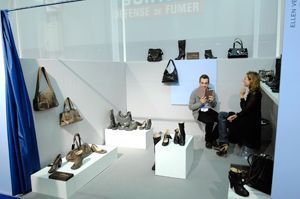 “A standman is an employee of a company, seconded to an exhibition, serving a certain area with exhibits and fulfilling the duties associated with the goals of organizing his workplace at the exhibition,” Vladimir Petelin gave this definition in his book, Fundamentals of Exhibition Management. However, the active development of the exhibition business in Russia and the growth of competition have changed the functions of stand-makers and increased the requirements for the work of the exhibition team.
“A standman is an employee of a company, seconded to an exhibition, serving a certain area with exhibits and fulfilling the duties associated with the goals of organizing his workplace at the exhibition,” Vladimir Petelin gave this definition in his book, Fundamentals of Exhibition Management. However, the active development of the exhibition business in Russia and the growth of competition have changed the functions of stand-makers and increased the requirements for the work of the exhibition team.
The basis for ineffective participation in the exhibition is several factors.
1. Lack of education for exhibition managers or those people who are considered as such.
2. Weak exhibition policy of the company.
3. Design of the exhibition stand, disposition of the exhibition team and exhibits.
4. “Team management” is still an alien science for the bulk of exhibiting enterprises.
5. Unconscious psychological motives of the standmen, often not taken into account at all.
EDUCATION
Knowledge of the fundamentals of exhibition management is still not considered by many exhibitors as mandatory. The management of the exhibition project is either left to the “full cycle” advertising agencies or the company “by themselves”, without any training, grow their own exhibition personnel with all the ensuing consequences. As a rule, after the manager holds a more or less successful exhibition or even two, he immediately begins to look for work with a higher salary. His place is occupied by the following, and everything is repeated. The rotation of personnel is probably a positive process, but its consequences are far from always unambiguous.
Possible solution to the problem
Introduction of the position of “exhibition business manager” at the enterprise, the use of educational programs for training in exhibition management that already exist in Russia, such as the programs of the Academy of National Economy, IPKIR, CCI of the Russian Federation (Moscow), the program of the Department of Exhibition Business, MBI (St. Petersburg) and the Institute exhibition business (Ekaterinburg).
Yes, these educational programs are not perfect in everything and require some refinement and modification. But you can certainly find the right one for advanced training. In addition, self-education should not be ruled out: www.exhibitoronline.com, www.ceir.org and www.edpa.com, where you can find dozens of articles on the exhibition business.
Organization of the exhibition space
The design of the stand, its functional areas, placement of exhibits should work in conjunction with the stand team. How to achieve this?
Possible way to achieve:
- the use of “brainstorming” to create the theme of the exhibition with the involvement of specialists from the marketing department, company management and a team of stand-men. The proposed Lorraine Denham, Creating an Exhibit Theme, Exhibitor Magazine, 2003 The 8 step-by-step formula for creating a «killer’ exposition theme for competitors can be the cornerstone of an exhibition project;
- the team of stand specialists for the first time does not get to the exhibition stand after the installers leave, but connects to the development of the stand and the exposure plan at the initial stage of the project;
- the choice of designers and builders of the exhibition stand is not made three weeks before the exhibition, but involves a long relationship;
- Mandatory inclusion of merchandising specialists in the composition of the participants of the project.
Management of stand team
Employees of most companies, accustomed to working with customers in the office according to a certain algorithm, at the exhibition find themselves in the position of sales assistant of a universal retail store with a constant flow of potential buyers. Psychologically, an even more complicated situation arises when the flow suddenly stops and it is necessary to leave the stand and invite a single visitor. Not everyone can worthily get out of such a psychological "trap".
What to do? How to build a job?
Western team management specialists traditionally, based on Western values, emphasize the individualism of each team member and its development in the process of joint work, which should ultimately bear fruit. However, if we talk about domestic experience, then, unfortunately, many years of observation of the work of poster teams at exhibitions lead to sad conclusions. Post-Soviet individualism is more likely to lead to "collective irresponsibility" for the final result. Here again, it should be noted that it is necessary to understand that exhibitions of different directions require completely different teams and a different approach to their management. If the goal of the exhibition is to attract a large number of new customers, then the team is selected from the employees of the sales department and even from sales representatives. In the latter case, the exhibition management has specific problems, discussed in detail in the article by Sherree R. Curry, “Booth Staff”. It describes seven reasons why sales representatives feel rather uncomfortable at the exhibition, while the author provides a list of reasonable advice for resolving conflict situations.
Possible solution to the problem:
- the formation of a permanent poster team;
- careful selection among the employees of the enterprise of the leader of the poster team with an exceptional set of personal and professional qualities and endowed with certain powers;
- Regular trainings of the poster team with the involvement of a wide range of specialists and psychologists;
- development of a special reward system for members of the poster team;
- development of standards describing goals, objectives, responsibilities, speech modules and reporting methodology for the results of the exhibition;
- Modern authors of motivation theories focus on the emotional component of work and believe that not only organizations should pay attention to the motives of employees, but in turn, each employee must consciously manage their motivation, control and maintain their emotional mood. The exhibition itself is so short that the maximum effect can be achieved only with the highest emotional recovery, increased concentration of attention and a heightened sense of responsibility.
Unconscious motives of behavior
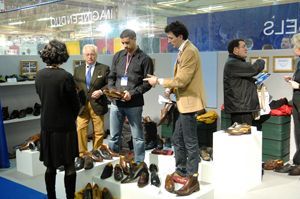 Doug MacLean, president of MacLean Marketing (Columbia, South Carolina), a consultancy and training company in trade shows, calls insignificant and barely noticeable misconducts by staff as an exposition. He is convinced that "the worst lies in the hidden and unconscious behavior of the staff, because they can harm you so that you do not even know what the reason is." Surveys conducted by the Chicago Center for the Exhibition Industry Research (CEIR) show that 60% of visitors attach great importance to personal communication with the booth staff. Charles Pappas (Seven Sneaky Ways Exhibit Staff Sabotages Your Booth) in his article "Seven Tricky Ways Exposition Staff Sabotages Your Booth" analyzed the opinions of experts on the behavioral problems of the stand team on a wealth of material from many exhibitions.
Doug MacLean, president of MacLean Marketing (Columbia, South Carolina), a consultancy and training company in trade shows, calls insignificant and barely noticeable misconducts by staff as an exposition. He is convinced that "the worst lies in the hidden and unconscious behavior of the staff, because they can harm you so that you do not even know what the reason is." Surveys conducted by the Chicago Center for the Exhibition Industry Research (CEIR) show that 60% of visitors attach great importance to personal communication with the booth staff. Charles Pappas (Seven Sneaky Ways Exhibit Staff Sabotages Your Booth) in his article "Seven Tricky Ways Exposition Staff Sabotages Your Booth" analyzed the opinions of experts on the behavioral problems of the stand team on a wealth of material from many exhibitions.
Consider these behavioral problems in relation to Russian exhibition reality.
Pairing. When visitors see the booth employees at a distance of about 50 cm from each other, they automatically avoid coming up, assuming that there is some kind of private conversation. A similar picture can often be observed at domestic exhibitions.
Congestion. Workers who are too shy or not too interested in communicating with visitors gather in a group to make it look like a meeting, for example. Quite often, this is, unfortunately, a completely natural process, for example, when someone from the company’s management appears on the stand. In domestic practice, this situation has a shade of understandable mentality: “we are all here, we all work!”
Zoning. Each employee of the poster team has its own comfortable communication zone. As long as you do not get into it, it seems that you do not exist. Matt Hill, a Hill Group employee, calls the phenomenon "Harry Porter's Invisible Cloak." The reverse side of this coin: too zealous, but poorly trained employees of your booth with forced smiles rush towards each visitor walking along the aisle with the duty phrase: “Could I help you?” As a rule, the average visitor is frightened and dissolves in the aisle.
Demonstration of the back. Wrong choice of exhibits, oversaturation of the stand and stupid location create additional opportunities for staff to “ignore” visitors.
Security. This is an option of psychological protection, designed to not work with visitors. Try to break through a dense chain of standmen standing with one foot (just in case!) In the aisle. In part, this can be justified by the presence of fairly small and expensive exhibits at the stand, as well as the absence of a utility room. At the same time, the organizers of the exhibition, with enviable constancy, make announcements on the radio every half an hour: "Watch your things." However, these excuses do not increase the efficiency of the exhibition!
The effect of "inguinal attack" in the style of Elvis Presley. Two-three of tall guys, stand employees, with their hands behind their backs, stand and sway from heels to toes. Have you watched? Obviously, this behavior is not neglect, but a manifestation of fatigue, but it makes an extremely negative impression on visitors!
And, finally, personal observations, I admit, are often specially provoked.
An attempt to obtain information about the presented product usually is downloaded quite successfully. True, if you need serious consultation on the spot, the qualifications of stand-up staff are often not enough. I ask a simple question about the comparative characteristics of this product and a similar one at the stand of a competitor opposite. Instant and inexplicable vicious reaction: “Here you go, man !!! And ask! ”Comments are unnecessary.
Possible solution to the problem:
- psychological testing of the poster team in preparation for the exhibition, business games;
- video filming during the exhibition by outsiders and post-exhibition analysis. It is advisable to demonstrate to the staff his behavior after the first exhibition day. However, this can cause negative consequences in the form of even more unnatural behavior;
- constant monitoring of personnel by the head of the stand and soft adjustment;
- during the exhibition, almost without violating the exposure, you can adjust the arrangement of exhibits, personnel and work schedules. Given the expected large flow of visitors, it is necessary to increase the number of personnel and provide for a work shift schedule;
- for various reasons there are inexpressibly boring exhibitions. In this case, it is possible to recommend various competitions between standmen, for example, for the best contact with a prospective client with a prize.
Nevertheless, I would like to finish on an optimistic note. The time is not far off when the "seconded" specialists will have sufficient knowledge and experience to perform complex work efficiently, and exhibitions will turn from high-cost events into highly effective ones.
| Please rate the article |
Materials on the topic

Why is it so important to work with customer reviews, analyze them and use them in your work?

How to implement sales funnels in the shoe business

Effective methods that will help improve the effectiveness of sellers

Service in the store: successes and mistakes

How to determine the amount of shoe purchases for the next season?
Popular
 Louis Vuitton opens a new factory in Italy
Louis Vuitton has opened its second shoe factory in Italy. After opening the first one in Fiesso d'Artico in Veneto, the LVMH flagship brand has just opened a new production site dedicated to this category of footwear in the industrial zone of Civitano in the Marche region. There is also another brand production facility in Tuscany, where bags and leather accessories are produced, writes fr.fashionnetwork.com.
Louis Vuitton opens a new factory in Italy
Louis Vuitton has opened its second shoe factory in Italy. After opening the first one in Fiesso d'Artico in Veneto, the LVMH flagship brand has just opened a new production site dedicated to this category of footwear in the industrial zone of Civitano in the Marche region. There is also another brand production facility in Tuscany, where bags and leather accessories are produced, writes fr.fashionnetwork.com.
 American buyers couldn't buy Birkin bags and sued Hermès
French fashion house Hermès is facing a lawsuit in California from two customers who were unable to purchase exclusive Birkin bags. The fashion house is accused of unfair commercial practices.
American buyers couldn't buy Birkin bags and sued Hermès
French fashion house Hermès is facing a lawsuit in California from two customers who were unable to purchase exclusive Birkin bags. The fashion house is accused of unfair commercial practices.
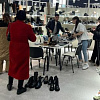 The Euro Shoes @ CAF exhibition was successfully held in Almaty
The Euro Shoes @ CAF exhibition was successfully held in Almaty. From March 11 to 13, the international exhibition of clothing, footwear and accessories Euro Shoes @ CAF was held in Almaty with great success.
The Euro Shoes @ CAF exhibition was successfully held in Almaty
The Euro Shoes @ CAF exhibition was successfully held in Almaty. From March 11 to 13, the international exhibition of clothing, footwear and accessories Euro Shoes @ CAF was held in Almaty with great success.  We are ready for active development in the Russian market
Friedrich Naumann, CEO of the Tamaris brand, told Shoes Report about the company’s ambitious plans, business development in Russia and expansion of the retail network, and also shared details about new collections and launches.
We are ready for active development in the Russian market
Friedrich Naumann, CEO of the Tamaris brand, told Shoes Report about the company’s ambitious plans, business development in Russia and expansion of the retail network, and also shared details about new collections and launches.
 “Discount for repairs” of clothes and shoes in France supported workshops
The French have calculated the benefits of a program that encourages consumers to repair clothes and shoes by providing discounts on these services in certified workshops. The “repair discount” program began operating in France in November last year. Over the six months of operation of this program, the number of calls to repair shops in France increased 10 times and amounted to 250 repairs. The French saved 000 million euros, writes leparisien.fr.
“Discount for repairs” of clothes and shoes in France supported workshops
The French have calculated the benefits of a program that encourages consumers to repair clothes and shoes by providing discounts on these services in certified workshops. The “repair discount” program began operating in France in November last year. Over the six months of operation of this program, the number of calls to repair shops in France increased 10 times and amounted to 250 repairs. The French saved 000 million euros, writes leparisien.fr.
 Coach turned to Big Data analysis and won the interest of a young audience
American handbag brand Coach has planned the success of its Tabby model among a younger audience, Generation Z, by turning to big data analysis, abandoning traditional and analogue tools, such as human intuition or the ability of any executive to sense “which way the wind will blow,” writes B.O.F.
Coach turned to Big Data analysis and won the interest of a young audience
American handbag brand Coach has planned the success of its Tabby model among a younger audience, Generation Z, by turning to big data analysis, abandoning traditional and analogue tools, such as human intuition or the ability of any executive to sense “which way the wind will blow,” writes B.O.F.
 Why is it so important to work with customer reviews, analyze them and use them in your work?
Customer reviews are of great, invaluable importance when selling a product. However, many companies do not always understand this: they do not collect reviews, respond only to positive ones and do not work with negative ones. This is a big mistake and omission of the brand. In this article, together with SR digital marketing expert Tatyana Vasilyeva, we understand the intricacies and nuances of working with customer reviews and explain why it is worth paying attention to your customer reviews, and how this can increase your sales.
Why is it so important to work with customer reviews, analyze them and use them in your work?
Customer reviews are of great, invaluable importance when selling a product. However, many companies do not always understand this: they do not collect reviews, respond only to positive ones and do not work with negative ones. This is a big mistake and omission of the brand. In this article, together with SR digital marketing expert Tatyana Vasilyeva, we understand the intricacies and nuances of working with customer reviews and explain why it is worth paying attention to your customer reviews, and how this can increase your sales.
 The Euro Shoes@CAF exhibition will be held in Almaty
From March 11 to 13, the Euro Shoes@CAF (Central Asia Fashion) exhibition will be held in Almaty at the Atakent exhibition complex. The exhibition, which is the largest international event in the fashion industry in Central Asia, will present collections of clothing, shoes and accessories.
The Euro Shoes@CAF exhibition will be held in Almaty
From March 11 to 13, the Euro Shoes@CAF (Central Asia Fashion) exhibition will be held in Almaty at the Atakent exhibition complex. The exhibition, which is the largest international event in the fashion industry in Central Asia, will present collections of clothing, shoes and accessories.
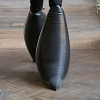 New “dutik” from Rick Owens presented at the show in Paris
Strange bulky shoes are another trend of our troubled times, and it’s impossible to ignore. American designer Rick Owens presented voluminous inflated latex boots at a show in Paris, which, according to him, were created in collaboration with the young London designer Straighteye, who likes to experiment with architectural volumes.
New “dutik” from Rick Owens presented at the show in Paris
Strange bulky shoes are another trend of our troubled times, and it’s impossible to ignore. American designer Rick Owens presented voluminous inflated latex boots at a show in Paris, which, according to him, were created in collaboration with the young London designer Straighteye, who likes to experiment with architectural volumes.
 VAGA SHOES is a new participant in the Euro Shoes premiere collection
The Russian women's shoe factory VAGA SHOES will take part for the first time in the international exhibition of footwear and accessories Euro Shoes premiere collection in Moscow.
VAGA SHOES is a new participant in the Euro Shoes premiere collection
The Russian women's shoe factory VAGA SHOES will take part for the first time in the international exhibition of footwear and accessories Euro Shoes premiere collection in Moscow.
 Euro Shoes will start operating on February 19 in Moscow!
The winter session of the international exhibition of footwear and accessories Euro Shoes premiere collection will be held in Moscow at the Expocenter from February 19 to 22. The organizers promise the presence of all the main participants at the exhibition, as well as new names from Europe, Asia and Russia.
Euro Shoes will start operating on February 19 in Moscow!
The winter session of the international exhibition of footwear and accessories Euro Shoes premiere collection will be held in Moscow at the Expocenter from February 19 to 22. The organizers promise the presence of all the main participants at the exhibition, as well as new names from Europe, Asia and Russia.
 John Galliano and Christian Louboutin created the Tabi collection for Maison Margiela
Maison Margiela creative director John Galliano and French shoe designer Christian Louboutin released a shoe collaboration that was included in the Maison Margiela Artisanal spring 2024 couture collection. The design duo created six versions of the Tabi shoe. All shoe models in the collection have a split toe - a characteristic touch of the signature Tabi shoe model of the Maison Margiela brand. And Christian Louboutin gave the shoe its signature red sole.
John Galliano and Christian Louboutin created the Tabi collection for Maison Margiela
Maison Margiela creative director John Galliano and French shoe designer Christian Louboutin released a shoe collaboration that was included in the Maison Margiela Artisanal spring 2024 couture collection. The design duo created six versions of the Tabi shoe. All shoe models in the collection have a split toe - a characteristic touch of the signature Tabi shoe model of the Maison Margiela brand. And Christian Louboutin gave the shoe its signature red sole.
 Euro Shoes starts in a month in Moscow!
There is less than a month left before the main exhibition of shoes and accessories in Russia - Euro Shoes Premiere Collection. The event will take place from February 19 to 22 in Moscow at the Expocenter, and, as always, in partnership with the largest international clothing exhibition in Russia, CPM Premiere Moscow.
Euro Shoes starts in a month in Moscow!
There is less than a month left before the main exhibition of shoes and accessories in Russia - Euro Shoes Premiere Collection. The event will take place from February 19 to 22 in Moscow at the Expocenter, and, as always, in partnership with the largest international clothing exhibition in Russia, CPM Premiere Moscow.
 Christian Louboutin presented a collection in a cowboy style
At the Loubi Show in Paris, the French luxury brand Christian Louboutin presented its fall 2024 collection, following the trend - in the style of the Wild West. It included cowboy boots and rhinestone loafers.
Christian Louboutin presented a collection in a cowboy style
At the Loubi Show in Paris, the French luxury brand Christian Louboutin presented its fall 2024 collection, following the trend - in the style of the Wild West. It included cowboy boots and rhinestone loafers.
 Camper has released innovative sneakers - designers
Spanish brand Camper's new Roku sneaker features six interchangeable components to create up to 64 different looks and color combinations. Roku means "six" in Japanese.
Camper has released innovative sneakers - designers
Spanish brand Camper's new Roku sneaker features six interchangeable components to create up to 64 different looks and color combinations. Roku means "six" in Japanese.
 Fashion Week takes place in Moscow
Fashion Week takes place in the Russian capital. Events include fashion shows, markets where you can purchase clothes, bags and accessories, and a B2B Showroom for fashion industry professionals.
Fashion Week takes place in Moscow
Fashion Week takes place in the Russian capital. Events include fashion shows, markets where you can purchase clothes, bags and accessories, and a B2B Showroom for fashion industry professionals.
 Why Rendez-Vous and Yandex Lavka released a “bread bag”
Shoe retailer Rendez-Vous announced the launch of a spring collaboration with Yandex Lavka and released a roll that resembles the shape of a woman’s handbag. This “Bread Bag” is presented in the Yandex.Lavka application at a price of 249 rubles. On the product packaging there is a promotional code for 1000 rubles, which can be spent in the Rendez-Vous network.
Why Rendez-Vous and Yandex Lavka released a “bread bag”
Shoe retailer Rendez-Vous announced the launch of a spring collaboration with Yandex Lavka and released a roll that resembles the shape of a woman’s handbag. This “Bread Bag” is presented in the Yandex.Lavka application at a price of 249 rubles. On the product packaging there is a promotional code for 1000 rubles, which can be spent in the Rendez-Vous network.
 Fashion trends Fall-Winter 2023/24 for commercial footwear purchases
Permanent contributor to Shoes Report. Elena Vinogradova, an expert in sales and purchases in the fashion business, prepared an overview of the trends for the autumn-winter 2023/24 season especially for us.
Fashion trends Fall-Winter 2023/24 for commercial footwear purchases
Permanent contributor to Shoes Report. Elena Vinogradova, an expert in sales and purchases in the fashion business, prepared an overview of the trends for the autumn-winter 2023/24 season especially for us.
 MSCHF and Crocs launch "Big Yellow Boots"
Creator of the Big Red Boots, Brooklyn brand MSCHF has teamed up with American plastic clog and sandal brand Crocs for another oversized shoe. The new Big Yellow Boots will go on sale on August 9th.
MSCHF and Crocs launch "Big Yellow Boots"
Creator of the Big Red Boots, Brooklyn brand MSCHF has teamed up with American plastic clog and sandal brand Crocs for another oversized shoe. The new Big Yellow Boots will go on sale on August 9th.
 Five rules of professional lighting for a shoe store - something that is relevant in any season
When developing a lighting concept for shoe retailers, it is important to take into account not only the history of the brand, the architectural content of the premises, the target audience of the stores, but also the seasonality of the goods. With the onset of the cold season, client preferences change: bright weightless shoes are replaced by more massive models in discreet dark colors. Despite significant differences in summer and winter collections, the overall philosophy of the brand, its recognition should remain unchanged at any time of the year. Tatyana Ryzhova, an SR lighting expert in fashion retail, has identified five basic rules for a competent lighting concept for a shoe store for readers of the magazine, which will help to present winter assortment to customers in a winning way.
Five rules of professional lighting for a shoe store - something that is relevant in any season
When developing a lighting concept for shoe retailers, it is important to take into account not only the history of the brand, the architectural content of the premises, the target audience of the stores, but also the seasonality of the goods. With the onset of the cold season, client preferences change: bright weightless shoes are replaced by more massive models in discreet dark colors. Despite significant differences in summer and winter collections, the overall philosophy of the brand, its recognition should remain unchanged at any time of the year. Tatyana Ryzhova, an SR lighting expert in fashion retail, has identified five basic rules for a competent lighting concept for a shoe store for readers of the magazine, which will help to present winter assortment to customers in a winning way.
 Bertsy: what to look for when choosing a model
Bertsy and tactical boots are becoming more and more relevant footwear, and not only because of the start of the hunting season. In Russia, there are several dozen enterprises producing this type of footwear. Oleg Tereshin, Deputy Chief Technologist of ZENDEN, told Shoes Report about the differences and features of ankle boots and what you should pay attention to when buying them in specialized retail and online.
Bertsy: what to look for when choosing a model
Bertsy and tactical boots are becoming more and more relevant footwear, and not only because of the start of the hunting season. In Russia, there are several dozen enterprises producing this type of footwear. Oleg Tereshin, Deputy Chief Technologist of ZENDEN, told Shoes Report about the differences and features of ankle boots and what you should pay attention to when buying them in specialized retail and online.
 EURO SHOES presents an updated section of the GLOBAL SHOES exhibition with collections of shoe and bag brands from Asian countries
EURO SHOES premiere collection is expanding. Along with the traditional pool of leading European footwear brands from Germany, Spain, Italy and Turkey, several dozen footwear and bag brands from the Middle Kingdom will be presented in the GLOBAL SHOES section at the Moscow Expocentre from August 29 to September 1.
EURO SHOES presents an updated section of the GLOBAL SHOES exhibition with collections of shoe and bag brands from Asian countries
EURO SHOES premiere collection is expanding. Along with the traditional pool of leading European footwear brands from Germany, Spain, Italy and Turkey, several dozen footwear and bag brands from the Middle Kingdom will be presented in the GLOBAL SHOES section at the Moscow Expocentre from August 29 to September 1.
 I doubt and object: how to find an approach to difficult clients?
How good and serene would be the work of a salesperson if the customers were calm, cheerful, always knew exactly what they wanted, and bought, bought, bought! It is a pity that this is possible only in dreams. Therefore, we will not dream, but we will act. Together with Maria Gerasimenko, a permanent author of SR, we understand the doubts and objections of buyers and build a strategy for working with them. Our expert pays special attention to the two main objections of buyers, on which 82% of sales are lost.
I doubt and object: how to find an approach to difficult clients?
How good and serene would be the work of a salesperson if the customers were calm, cheerful, always knew exactly what they wanted, and bought, bought, bought! It is a pity that this is possible only in dreams. Therefore, we will not dream, but we will act. Together with Maria Gerasimenko, a permanent author of SR, we understand the doubts and objections of buyers and build a strategy for working with them. Our expert pays special attention to the two main objections of buyers, on which 82% of sales are lost.
 Two prominent Russian fashion designers Vyacheslav Zaitsev and Valentin Yudashkin passed away
One after another, two days apart, Vyacheslav Zaitsev and Valentin Yudashkin, outstanding fashion designers, whose work for the whole world was a kind of hallmark of fashionable Russia, left this world.
Two prominent Russian fashion designers Vyacheslav Zaitsev and Valentin Yudashkin passed away
One after another, two days apart, Vyacheslav Zaitsev and Valentin Yudashkin, outstanding fashion designers, whose work for the whole world was a kind of hallmark of fashionable Russia, left this world.
 World Footwear Yearbook: Global footwear production reaches 23,9 billion pairs and is back to pre-pandemic levels
The Portuguese association of shoe manufacturers APICCAPS published the 13th edition of the international statistical bulletin World Footwear Yearbook for 2023, according to which in 2022 the production and export of shoes worldwide increased by 7,6% and 9%, respectively, and the world production of shoes reached 23,9 billion couples and returned to pre-pandemic levels.
World Footwear Yearbook: Global footwear production reaches 23,9 billion pairs and is back to pre-pandemic levels
The Portuguese association of shoe manufacturers APICCAPS published the 13th edition of the international statistical bulletin World Footwear Yearbook for 2023, according to which in 2022 the production and export of shoes worldwide increased by 7,6% and 9%, respectively, and the world production of shoes reached 23,9 billion couples and returned to pre-pandemic levels.
 Rostov footwear brand Novak presented a collection of sneakers and sneakers
In the spring-summer 2023 season, the Rostov-on-Don shoe brand Novak presented a cute collection of sneakers and sneakers for every day. The upper of the shoe is made of genuine leather, suede, nubuck, the sole is made of light EVA.
Rostov footwear brand Novak presented a collection of sneakers and sneakers
In the spring-summer 2023 season, the Rostov-on-Don shoe brand Novak presented a cute collection of sneakers and sneakers for every day. The upper of the shoe is made of genuine leather, suede, nubuck, the sole is made of light EVA.
 How to create selling visual content for online based on the identified unique selling proposition?
What is a USP (unique selling proposition) and what is it for? Why is the USP creation service in great demand among fashion retailers today? How to create a working USP? Answers questions and provides step-by-step guidance on how to define your unique selling proposition and work with it to increase online sales, Tatyana Vasilyeva, an SR expert in the promotion and development of fashion brands.
How to create selling visual content for online based on the identified unique selling proposition?
What is a USP (unique selling proposition) and what is it for? Why is the USP creation service in great demand among fashion retailers today? How to create a working USP? Answers questions and provides step-by-step guidance on how to define your unique selling proposition and work with it to increase online sales, Tatyana Vasilyeva, an SR expert in the promotion and development of fashion brands.
 Shoe educational program: what shoe soles are made of
“What is the difference between TEP and EVA? What does tunit promise me? Is PVC glue? What is the sole of these shoes made of? ”- the modern buyer wants to know everything. In order not to smash his face in front of him and be able to explain whether such a sole suits him in soles, carefully read this article. In it, process engineer Igor Okorokov tells what materials the soles of shoes are made of and what makes each of them so good.
Shoe educational program: what shoe soles are made of
“What is the difference between TEP and EVA? What does tunit promise me? Is PVC glue? What is the sole of these shoes made of? ”- the modern buyer wants to know everything. In order not to smash his face in front of him and be able to explain whether such a sole suits him in soles, carefully read this article. In it, process engineer Igor Okorokov tells what materials the soles of shoes are made of and what makes each of them so good.
 How to set prices that will earn
Some businessmen still confuse the concept of margin with the concept of trade margins and set prices for their goods, guided solely by the example of competitors. No wonder they go broke! Analyst at the Academy of Retail Technologies Maxim Gorshkov gives several tips and formulas with which you can set not only ruinous, but also profitable prices.
How to set prices that will earn
Some businessmen still confuse the concept of margin with the concept of trade margins and set prices for their goods, guided solely by the example of competitors. No wonder they go broke! Analyst at the Academy of Retail Technologies Maxim Gorshkov gives several tips and formulas with which you can set not only ruinous, but also profitable prices.
 Sales of shoes and accessories: effective techniques for business rhetoric
Which speech modules are effective in communicating with potential and current customers of shoe stores, and which are not, Anna Bocharova, a business consultant, knows.
Sales of shoes and accessories: effective techniques for business rhetoric
Which speech modules are effective in communicating with potential and current customers of shoe stores, and which are not, Anna Bocharova, a business consultant, knows.
 We form the salary of sellers: expert advice
“How do you charge your consultants for personal or general sales?” Is one of the most popular questions causing a lot of controversy and gossip on the online forums of retail business owners. Indeed, how to properly form the earnings of sellers? But what about bonuses, where to get a sales plan from, do employees allow them to buy goods at discounted stores? In search of truth, the Shoes Report turned to a dozen shoe retailers, but no company wanted to disclose its motivation system - the process of its development was too complicated and individual. Then we asked four business consultants, and finally became convinced that the topic of seller motivation is very complex, because even our experts could not come to a common opinion.
We form the salary of sellers: expert advice
“How do you charge your consultants for personal or general sales?” Is one of the most popular questions causing a lot of controversy and gossip on the online forums of retail business owners. Indeed, how to properly form the earnings of sellers? But what about bonuses, where to get a sales plan from, do employees allow them to buy goods at discounted stores? In search of truth, the Shoes Report turned to a dozen shoe retailers, but no company wanted to disclose its motivation system - the process of its development was too complicated and individual. Then we asked four business consultants, and finally became convinced that the topic of seller motivation is very complex, because even our experts could not come to a common opinion.
 The whole truth about Bayer. Who is he and how to become one?
Bayer is no longer a new, but still a popular and sought-after profession. It’s fashionable to be a buyer. Buyers are at the origins of the emergence and development of trends. If the designer offers his vision of fashion in the season, then the buyer selects the most interesting commercial ideas. It is on buyers that the policy of sales of stores and what, in the end, the buyer will wear depends on. This profession is surrounded by a magical fleur, often associated with a lack of understanding of what exactly is the work of a buyer.
The whole truth about Bayer. Who is he and how to become one?
Bayer is no longer a new, but still a popular and sought-after profession. It’s fashionable to be a buyer. Buyers are at the origins of the emergence and development of trends. If the designer offers his vision of fashion in the season, then the buyer selects the most interesting commercial ideas. It is on buyers that the policy of sales of stores and what, in the end, the buyer will wear depends on. This profession is surrounded by a magical fleur, often associated with a lack of understanding of what exactly is the work of a buyer.
 Technology Selling Issues
There is nothing worse than meeting the buyer with the words “Hello, can I help you with something?”, Because the seller works in the store just to help. Criticizing this well-established pattern of communication with the buyer, Andrei Chirkarev, business coach for effective sales and the founder of the New Economy project, shares the technology of truly selling issues with readers of Shoes Report.
Technology Selling Issues
There is nothing worse than meeting the buyer with the words “Hello, can I help you with something?”, Because the seller works in the store just to help. Criticizing this well-established pattern of communication with the buyer, Andrei Chirkarev, business coach for effective sales and the founder of the New Economy project, shares the technology of truly selling issues with readers of Shoes Report.
 Fur, and not only: types of lining
In the production of winter footwear, various materials are used that are designed to retain heat and meet the requirements of consumers: natural sheepleather, artificial fur, artificial fur from natural wool and others. All types of lining fur have their own advantages and disadvantages. Let's consider the properties of each of them.
Fur, and not only: types of lining
In the production of winter footwear, various materials are used that are designed to retain heat and meet the requirements of consumers: natural sheepleather, artificial fur, artificial fur from natural wool and others. All types of lining fur have their own advantages and disadvantages. Let's consider the properties of each of them.
 Retail Arithmetic
Before you begin to solve specific problems, you need to find out how accurately all the leaders of your company understand the basic terminology of retail.
Retail Arithmetic
Before you begin to solve specific problems, you need to find out how accurately all the leaders of your company understand the basic terminology of retail.
 How to fire a worker without tears, scandal and trial
Sooner or later, any manager is faced with the need to part with an employee. Properly and on time the dismissal procedure will save the company money, and the boss himself - nerves and time. But why sometimes, knowing that a break in relations is inevitable, we put off the decision for months?
How to fire a worker without tears, scandal and trial
Sooner or later, any manager is faced with the need to part with an employee. Properly and on time the dismissal procedure will save the company money, and the boss himself - nerves and time. But why sometimes, knowing that a break in relations is inevitable, we put off the decision for months?






